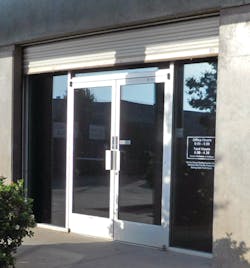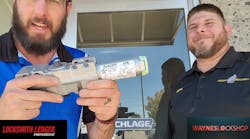Aluminum stile glass storefront doors in both single and double-door configurations are a common sight at strip malls, restaurants, multi-tenant manufacturing complexes, office buildings, etc. The door's framework is extruded aluminum in varying widths with a large glass panel. Aluminum is very efficient, as it can require little or no maintenance. The glass panel provides visibility from the exterior and the interior, offering a more welcoming appearance.
These aluminum stile glass storefront doors for most applications are very flexible and can easily be converted, retrofit or have add-on products to satisfy the customers ‘needs.
Storefront doors are available in three different widths of aluminum stiles: narrow, medium and wide. Rough sizes are 2" narrow, 3-1/2" medium and 5" wide. These measurements are for the outer extrusion only; it does not include the portion of the stile that retains the glass.
Regardless of the different widths, aluminum stile lock hardware can be used in most doors. The stile depth is available in different sizes; however, the most common is 1-3/4". If the door is less than 1-3/4" deep, specialty hardware may be required.
The aluminum stile glass storefront doors can be installed into the jambs in center, flush or partial recess configurations. Depending upon the application, doors can be mounted using hinges, continuous hinges or pivots. Pivots are normally used if there is a concealed door closer in the header or floor, which provides a "cleaner" appearance. Center hung pivots are installed for double-swing doors.
Surface-mounted door closers can be installed onto aluminum stile glass storefront doors. The upper rail is normally larger enough to accommodate the closer body with the arm mounted onto the header in either the Regular Arm or Parallel Arm configurations.
Aluminum storefront doors can be equipped with a variety of door hardware including exit devices, mortised locks, pushbutton locks, push bars, pull handles, levers and paddles. Push bars and pull handles are normally installed for non-latching (passage) applications where the locks if applicable are locked only during non-business hours. Push bars are mounted at 37-1/2" above the finished floor. Pull handles are mounted 42" above the finished floor. Locks using a mortise cylinder have the centerline of the cylinder mounted at 34" above the finished floor.
Access control can be via mechanical key mortised or surface lock mechanism, electrified deadlatch, a mechanical pushbutton lock or electromechanical pushbutton lock. Mechanical locks mechanisms include deadlatch, pivot bolt deadbolt or hookbolts, and exit device latches.
The most common lock mechanism is probably the pivot bolt deadbolt, having been around for more than 50 years. The standard pivot bolt deadbolt is 5/8" x 1-3/8" x 2-7/8" with a 1-3/8" throw. Today's models are usually made of laminated steel. The long pivoting throw compensates for the occasional large gap between the door and the jamb or second door. For double-door applications, key operated and radiused faced flush bolts are available to secure the inactive door.
Pivot bolt deadbolts are normally "unlocked during business hours." An exit indicator can provide notification of the door's condition. A cutout in the hookbolt provides the locking function for sliding doors. Pivot bolt deadbolt and the hookbolt lock bodies are operated by one or two mortise cylinders, thumbturn, lever or paddle handle.
Aluminum stile glass door mortised locks are available in three standard backsets: 31/32", 1-1/8" and 1-1/2". The hookbolt and pivot bolt deadbolt bodies are non-handed. However, beveled faceplates are handed. Non-handed faceplates are flat or radiused. Deadlatch models are handed, and not field reversible. Mortise lock cylinders can be from 1" to about 1-3/8" depending upon the type of cylinder guard being used.
For remote activation of the deadlatch, Adams Rite introduced the Steel Hawk 4300, a non-handed electrified latch that is a direct replacement for the 4500/4700/4900 Series using the same strike.
To resist unauthorized entry, manufacturers have developed varying forms of protection for aluminum stile mortised lock and exit devices. These include cylinder, latch and strike protection. These normally hardened metal cones and plates cover the outer diameter of the mortise cylinder or along the area between the door and jamb. Specialized plates wrap around the jamb, having a strike opening. Latch plates are available in different configurations to accommodate the mounting location of the door - flush, partial recess or center hung.
Up until a few years ago, the three styles were the only options. Then Adams Rite introduced the Dual Force 2190 interconnected deadbolt and latchbolt lock for aluminum stile doors. The 2190 provides deadbolt security with the interior trim able to retract both the deadbolt and latchbolt for egress in a single motion.
Installation
There are several methods for installing the aluminum stile lock bodies. The labor-intensive method uses a tape measure and pencil or paper template. Once every opening is marked, carefully cut the openings using a jigsaw and holesaw. Finish the openings using a round and flat file for the fine adjustments. As an alternative, Major Manufacturing has the GIT-30 Template Guide Holder and aluminum templates for the faceplate opening and the mortise cylinder, thumbturn or cam plug openings for the stile and the strike opening. The openings are cut using a router and bit, drill bit or holesaw.
Once door prep has been completed, there are three methods for securing the lock body within the stile. First, some door companies drill and tap into the aluminum extrusion for the mounting screws. The lock body is then secured by two flat head machine screws.
The second method is to use metal brackets to install the lock body in an aluminum stile door. The two brackets have three 10-32 tapped holes. The two end holes secure the lock. They are different to accommodate different applications. To install, drill a hole above and below the faceplate cutout to secure the brackets to the door edge. Position the bracket to accommodate the installation. Once the bracket has been secured, slide the lock body into the opening and secure it using two mounting screws.
The third method is to use mounting bridges. They provide a mounting surface within the stile and screw receptacle for installing the lock body. An installation tool is required to install them. Mounting bridges eliminate the need to drill mounting holes into the edge of the stile.
A number of surface-mounted locks can be installed onto aluminum stile glass doors including exit devices and pushbutton locks. Exit devices are available as rim, mortised or vertical rod. Exit devices are available with a push bar/bar or crossbar devices. Narrow stile exit devices can accommodate stiles as narrow as 1-3/8". For wide stile storefront doors, the standard chassis exit device can probably be used.
Note: Kits and pieces are available for converting a mortised lock to an exit device or pushbutton lock. A blank faceplate, two hole filler plates and the necessary mounting hardware are required.
When installing exit devices, guards and hardware protection products can protect the end caps and surface vertical rod bottom rods from the damage caused by carts and/or gurneys passing through doorways.
There are pushbutton locks specifically designed for aluminum stile glass doors. Mechanical pushbutton locks have a single access code and are usually equipped with an override cylinder. Most aluminum stile mechanical locks are available with from five to 13 pushbuttons, having a code of four to seven digits. These locks (trim) have a narrow footprint and do not require a large cross bore opening. Most are designed to retrofit onto doors equipped with the standard deadlatch mortise body.
Mechanical pushbutton locks can be equipped with a thumbturn, knob or lever handle. Thumbturn-equipped locks operating deadbolt lock mechanisms do not require two hands for operation. One hand can rotate the thumbturn to unlock the door and the same hand can open the door. Thumbturn equipped locks that operate deadlatch lock mechanisms require two hands for operation. Therefore, they do not meet Americans With Disabilities Act (ADA) requirements.
Most pushbutton lock models are non-handed or field reversible. Electromechanical pushbutton lock models can have hundreds and even thousands of user codes in a hierarchical format. Most have audit trail, event schedules and real time clock as standard. Beyond the pushbutton, electromechanical locks can offer proximity, Mifare®, DESfire® and iClass SmartTM Card readers.
Most of the electromechanical and mechanical pushbutton lock manufacturers state that their products retrofit various Adams Rite® mortise products. Some locks manufacturers include the lock mechanism.
For more information, contact your local locksmith distributor or the following manufacturers:
Adams Rite: www.adamsrite.com.
Alarm Lock Systems Inc: www.alarmlock.com.
Calibre Door Closers, Inc.: www.calibredoorclosers.com.
Codelocks LLC: www.codelocks.us.
GKL Products: www.gklproducts.com.
International Door Closer Inc: www.intldoorclosers.com.
Jackson: www.crlaurence.com/
Kaba Access: www.kaba-ilco.com/kaba-access-control.
Lockey Digital Systems Inc.: www.lockeyusa.com.
Major Manufacturing, Inc.: www.majormfg.com
Rixson: www.rixson.com
For a more complete listing of manufacturers, see the Buyers Guide at http://www.locksmithledger.com/directory.






